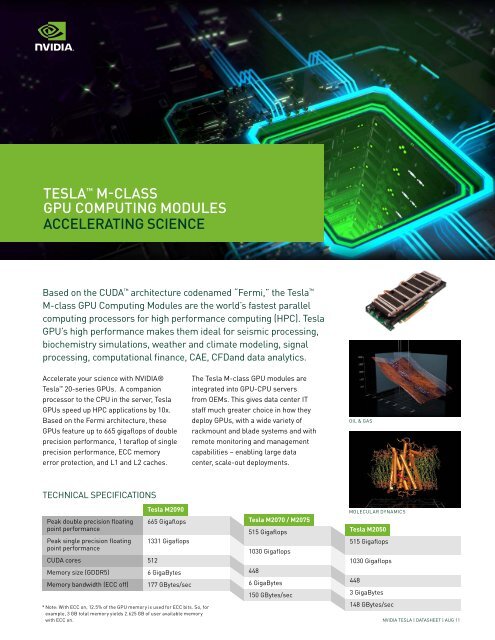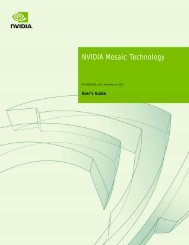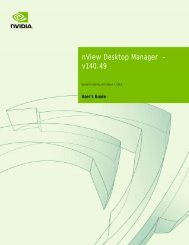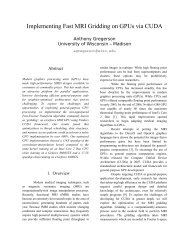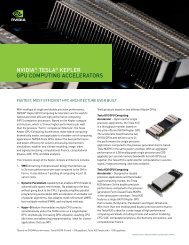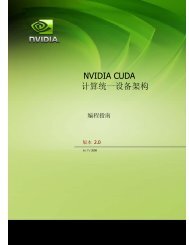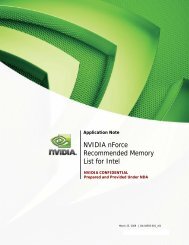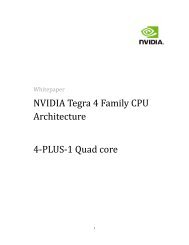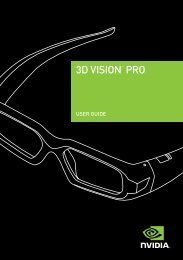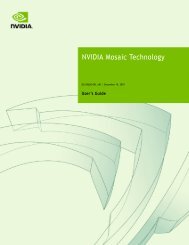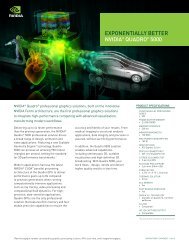TESLA⢠M-CLASS GPU CoMPUTinG ModULES ... - Nvidia
TESLA⢠M-CLASS GPU CoMPUTinG ModULES ... - Nvidia
TESLA⢠M-CLASS GPU CoMPUTinG ModULES ... - Nvidia
Create successful ePaper yourself
Turn your PDF publications into a flip-book with our unique Google optimized e-Paper software.
TESLA M-Class<br />
<strong>GPU</strong> Computing Modules<br />
Accelerating Science<br />
Based on the CUDA architecture codenamed “Fermi,” the Tesla <br />
M-class <strong>GPU</strong> Computing Modules are the world’s fastest parallel<br />
computing processors for high performance computing (HPC). Tesla<br />
<strong>GPU</strong>’s high performance makes them ideal for seismic processing,<br />
biochemistry simulations, weather and climate modeling, signal<br />
processing, computational finance, CAE, CFDand data analytics.<br />
Accelerate your science with NVIDIA®<br />
Tesla 20-series <strong>GPU</strong>s. A companion<br />
processor to the CPU in the server, Tesla<br />
<strong>GPU</strong>s speed up HPC applications by 10x.<br />
Based on the Fermi architecture, these<br />
<strong>GPU</strong>s feature up to 665 gigaflops of double<br />
precision performance, 1 teraflop of single<br />
precision performance, ECC memory<br />
error protection, and L1 and L2 caches.<br />
The Tesla M-class <strong>GPU</strong> modules are<br />
integrated into <strong>GPU</strong>-CPU servers<br />
from OEMs. This gives data center IT<br />
staff much greater choice in how they<br />
deploy <strong>GPU</strong>s, with a wide variety of<br />
rackmount and blade systems and with<br />
remote monitoring and management<br />
capabilities – enabling large data<br />
center, scale-out deployments.<br />
oil & gas<br />
TECHNICAL SPECIFICATIONS<br />
Peak double precision floating<br />
point performance<br />
Peak single precision floating<br />
point performance<br />
CUDA cores<br />
Memory size (GDDR5)<br />
Memory bandwidth (ECC off)<br />
Tesla M2090<br />
665 Gigaflops<br />
1331 Gigaflops<br />
512<br />
6 GigaBytes<br />
177 GBytes/sec<br />
* Note: With ECC on, 12.5% of the <strong>GPU</strong> memory is used for ECC bits. So, for<br />
example, 3 GB total memory yields 2.625 GB of user available memory<br />
with ECC on.<br />
Tesla M2070 / M2075<br />
515 Gigaflops<br />
1030 Gigaflops<br />
448<br />
6 GigaBytes<br />
150 GBytes/sec<br />
Molecular Dynamics<br />
Tesla M2050<br />
515 Gigaflops<br />
1030 Gigaflops<br />
448<br />
3 GigaBytes<br />
148 GBytes/sec<br />
NVIDIA TESLA | DATASHEET | AUG 11
TESLA M-<strong>CLASS</strong> <strong>GPU</strong> COMPUTING MODULE<br />
Features<br />
Hundreds of CUDA Cores<br />
ECC Memory Error Protection<br />
Up to 6GB of GDDR5 memory<br />
per <strong>GPU</strong><br />
System Monitoring Features<br />
L1 and L2 caches as part of the<br />
NVIDIA Parallel DataCache <br />
NVIDIA GigaThread Engine<br />
Asynchronous Transfer with<br />
dual DMA engines<br />
Flexible programming<br />
environment with broad support<br />
of programming languages<br />
and APIs<br />
Benefits<br />
Delivers up to 665 Gigaflops of double-precision peak<br />
performance in each <strong>GPU</strong>, enabling servers from leading<br />
OEMs to deliver more than a teraflop of double-precision<br />
performance per 1 RU of space. Single precision peak<br />
performance is over one Teraflop per <strong>GPU</strong>.<br />
Meets a critical requirement for computing accuracy and<br />
reliability in datacenters and supercomputing centers.<br />
Internal register files, L1/L2 caches, shared memory, and<br />
external DRAM all are ECC protected.<br />
Maximizes performance and reduces data transfers by<br />
keeping larger data sets in local memory that is attached<br />
directly to the <strong>GPU</strong>.<br />
Integrates the <strong>GPU</strong> subsystem with the host system’s<br />
monitoring and management capabilities such as IPMI or<br />
OEM-proprietary tools. IT staff can thus manage the <strong>GPU</strong><br />
processors in the computing system using widely used<br />
cluster/grid management solutions.<br />
Accelerates algorithms such as physics solvers, ray-tracing,<br />
and sparse matrix multiplication where data addresses are<br />
not known beforehand.<br />
Maximizes the throughput by faster context switching that<br />
is 10X faster than previous architecture, concurrent kernel<br />
execution, and improved thread block scheduling.<br />
Turbocharges system performance by transferring data<br />
over the PCIe bus while the computing cores are crunching<br />
other data.<br />
Choose C, C++, OpenCL, DirectCompute, or Fortran to express<br />
application parallelism and take advantage of the innovative<br />
“Fermi” architecture.<br />
Software and Drivers<br />
> > Software applications page:<br />
http://www.nvidia.com/object/vertical_solutions.html<br />
> > Tesla M-class <strong>GPU</strong> computing modules are supported for both Linux and<br />
Windows 64-bit<br />
––<br />
Drivers – NVIDIA recommends that users get drivers for M-series<br />
products from their System OEM to ensure that driver is qualified by the<br />
OEM on their system. Latest drivers can be downloaded from<br />
http://www.nvidia.com/drivers<br />
––<br />
Learn more about Tesla data center management tools at<br />
http://www.nvidia.com/object/software-for-tesla-products.html<br />
> > Software development tools are available at<br />
http://www.nvidia.com/object/tesla_software.html<br />
To learn more about NVIDIA Tesla, go to www.nvidia.com/tesla<br />
© 2011 NVIDIA Corporation. All rights reserved. NVIDIA, the NVIDIA logo, NVIDIA Tesla, CUDA, GigaThread, Parallel DataCache, and<br />
Parallel NSight are trademarks and/or registered trademarks of NVIDIA Corporation. All company and product names are trademarks or<br />
registered trademarks of the respective owners with which they are associated. Features, pricing, availability, and specifications are all<br />
subject to change without notice.


